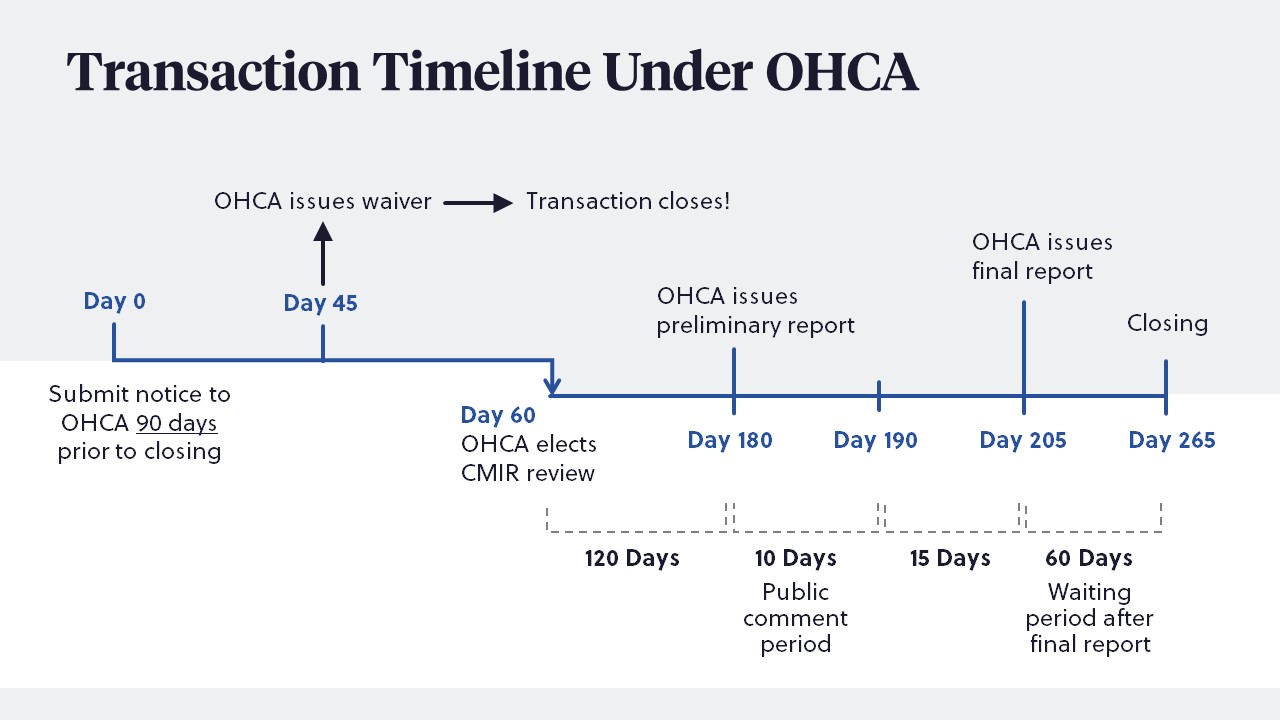The enactment of the Health Care Quality and Affordability Act (HCQAA) in June 2022 provided statutory authority for the creation of California’s Office of Health Care Affordability (OHCA) and its oversight over “Health Care Entities” (HCEs).
After publishing a series of proposed regulations through its emergency rulemaking process and receiving multiple rounds of commentary from industry stakeholders, on December 18, 2023, OHCA issued much-awaited final regulations that govern the notice and approval requirements for HCEs that undergo “material change transactions” that will close on or after April 1, 2024.[1] On January 1, 2024, OHCA began accepting online filings for material change transactions closing on or after April 1.
Under the HCQAA and final regulations, OHCA is armed with the authority to evaluate a transaction’s costs and market impacts to determine whether the transaction threatens market competition or healthcare affordability. In addition, commencing in 2025, expenditures by HCEs will be monitored and cannot exceed annual statewide cost targets established by OHCA.
Critically, although the HCQAA and its final regulations characterize this process as a “notice” to OHCA, in effect, this process will require approval by OHCA in order for a transaction to proceed. This is consistent with other “notice” processes required of California nonprofit corporations and health facilities subject to the oversight of the Office of the California Attorney General (California AG) and has been acknowledged as such by representatives of that office.
In analyzing whether a transaction will require notice to and approval from OHCA, there are three key steps:
- Step 1: Is the organization an HCE?
- Step 2: Does the HCE meet the required revenue thresholds?
- Step 3: Is the transaction a “material change transaction” that requires notice?
Below, we review each of these steps in greater detail.
Which entities are required to provide notice to OHCA?
The first step is to confirm whether the organization is an HCE subject to OHCA.
Under the HCQAA, healthcare entities operating in California include payers, fully integrated delivery systems, and providers, each specifically defined by the statute and the final regulations. Under the HCQAA, “providers” include the following entities:
- Physician organizations comprised of 25 or more physicians or if fewer than 25 physicians, physician organizations considered “high-cost outliers”
- Risk-bearing organizations
- Health facilities, such as general acute care hospitals, acute psychiatric hospitals, nursing facilities, intermediate long-term care facilities, and hospices
- Outpatient clinics, including 1206(d) hospital outpatient departments, 1206(l) medical foundations, 1204(a) community clinics, and 1204(b) specialty clinics
- Ambulatory surgery centers
- Clinical laboratories
- Imaging facilities
The final regulations expand the definition of HCE to include:
- Pharmacy benefits managers; and
- Parents, affiliates, or subsidiaries that act as an agent in California on behalf of a payer and
- Control, govern, or are financially responsible for the HCE or are subject to the control, governance, or financial control of the HCE or
- In the case of a subsidiary, are a subsidiary acting on behalf of another subsidiary.
Do management services organizations qualify?
Notably, although prior versions of the proposed regulations attempted to capture management services organizations (MSOs) within the definition of HCE, the final regulations removed explicit references to MSOs from the definition of HCE. During an OHCA Board Meeting on December 19, 2023, in response to a stakeholder comment, the OHCA Board confirmed that MSOs are not considered HCEs under the current version of the law. The OHCA Board indicated that MSOs may still fall within OHCA’s purview if they are involved in transactions with HCEs that otherwise trigger OHCA’s notice obligations. For example, HCEs that grant MSOs contracting authority to negotiate with payers and meet revenue materiality thresholds may trigger the notice requirements (see below). That said, based on the final regulations, an MSO would only independently qualify as an HCE if it is “a parent, affiliate, or subsidiary that acts as an agent in California on behalf of a payer” and controls or is controlled by an HCE—without further clarification or guidance from OHCA, it would be unlikely that an MSO will be able to meet these definitions and qualify as an HCE. This highlights the importance of ensuring accurate and thorough process information for healthcare entities involved in such transactions.
Other providers
Consistent with a plain reading of the HCQAA, OHCA’s guidance also confirmed that dental providers are not deemed HCEs under the law.
If the organization does not meet the definition of HCE, the organization is not subject to the OHCA notice requirements.
What are the applicable thresholds for HCEs to be subject to OHCA?
If the organization is an HCE, it must also meet at least one of the following revenue-related thresholds and will be subject to the notice requirements:
- The HCE has annual revenue of at least $25 million or owns or controls California assets of at least $25 million;
- The HCE has annual revenue of at least $10 million or owns or controls California assets of at least $10 million and is involved in a transaction with any HCE that meets the above $25 million threshold, or
- The HCE is located in a designated primary care health professional shortage area (HPSA).
If multiple parties to the transaction meet these thresholds, each party would be required to file a separate notice. OHCA has made no indication that parties may jointly file if more than one party to a transaction is an HCE and meets the relevant thresholds.
The definition of “revenue” is based on the total average annual California-derived revenue received for all healthcare services by the HCE and its affiliates over the prior three-year period. Importantly, this means that organizations with limited operations in California may not meet the threshold requirements and are excused from the OHCA notice process.
Further, the inclusion of “affiliates” from the revenue calculation implicates newly formed organizations that are affiliated with HCEs, and that would not otherwise meet these revenue thresholds. In other words, an HCE cannot form a new entity that it owns or controls to serve as a holding company buyer in order to avoid the OHCA notice requirements since the revenue of the parent would be part of the calculation.
An organization that meets the definition of HCE but does not meet the threshold requirements will not be subject to the notice requirements.
What transactions are implicated?
If the entity is considered an HCE and meets the revenue thresholds, we determine if the transaction is a “material change transaction” under the final regulations.
Under the final regulations, the following types of transactions are considered a “material change transaction” that requires notice. It is important to note that some of these involve financial thresholds, while others are related to a transfer or change in assets or control:
- The proposed fair market value of the transaction is $25 million or greater, and the transaction concerns the provision of healthcare services;
- The transaction is likely to increase the annual revenue of any HCE that is a party to the transaction by at least $10 million or 20% of annual revenue at normal or stabilized levels of utilization or operation;
- The transaction involves the sale, transfer, or other disposition of 25% or more of the assets of the submitter;
- The transaction involves a transfer or change in control, responsibility, or governance of the submitter, which means:
- The transaction would result in the transfer of 25% or more of the voting power of the members of the governing body of an HCE, such as by adding one or more members, substituting one or more members, or through any other type of arrangement, written or oral; or
- The transaction would vest voting rights significant enough to constitute a change in control, such as supermajority rights, veto rights, and similar provisions, even if ownership shares or representation on a governing body are less than 25%;
- The transaction will result in an entity contracting with payers on behalf of consolidated providers and is likely to increase annual California-derived revenue of any providers in the transaction by at least $10 million or 20% of annual California-derived revenue;
- In its guidance, OHCA describes that this circumstance could include multiple physician groups or providers in a geographic location that transfer control to and/or authorize an MSO to contract with payers on their behalf, as OHCA views these types of arrangements as potentially leading to consolidation and market power. Thus, agreements with MSOs should be narrowly tailored and reserve contracting authority to the provider. We further note that this circumstance may implicate arrangements between providers and clinically integrated networks, provided that the revenue prong of this circumstance is also anticipated to be met.
- The transaction involves the formation of a new entity for the provision of healthcare services in California, projected to have at least $25 million in California-derived annual revenue or the transfer of control of California assets related to the provision of healthcare services valued at $25 million or more;
- The transaction is part of a series of related transactions for the same or related healthcare services occurring over the past ten years involving the same or affiliated HCEs, or
- The transaction involves the acquisition of an HCE by another entity, and the acquiring entity has consummated similar transactions in the last ten years with entities that provide related healthcare services.
- In its guidance, OHCA describes that its focus here is to determine if monopolistic behavior is occurring, which tracks with concerns raised by the Federal Trade Commission (FTC) in connection with “roll-ups,”[2] in which buyers engage in a series of similar or related transactions that would otherwise avoid the regulatory thresholds and “in which they are buying up similar healthcare entities, thereby monopolizing the market and driving up prices for consumers.”
Are any transactions exempt?
Certain transactions are exempt from the OHCA notice requirements even if the organization is an HCE that meets the revenue thresholds.
Specifically, transactions within the “usual and regular” course of business and corporate restructurings are exempt from the notice requirements. OHCA notes that this is a fact-specific inquiry, which is based on precedent established by the California AG and the FTC, that exempts “usual and regular course of activities” of nonprofit corporations and transfers of goods or realty “in the ordinary course of business,” respectively.
In addition, transactions that are already subject to other California regulatory review processes (e.g., nonprofit health facility transactions that require approval from the California AG or health plan transactions subject to the oversight of the California Department of Managed Health Care) are generally exempt.
What does the notice include?
Notices submitted to OHCA require extensive and detailed information about the transaction, the parties, and the potential impact of the transaction, along with supportive documentation related to the transaction.
Each party entering into a material change transaction that is an HCE that meets the revenue thresholds must file a notice—at this time, there is no “joint” filing process available.
Notices will be publicly posted on OHCA’s website. OHCA has identified multiple categories of information that may be deemed confidential, and submitters must request that materials be treated as confidential and identify the justification for such treatment. OHCA retains discretion to grant or deny such requests, but a limited set of materials will be automatically deemed confidential by OHCA (specifically, marked-confidential versions of stock purchase agreements, compensation documents, contract rates, transaction valuation documentation, and unredacted résumés).
Cost and Market Impact Review
If OHCA finds that a transaction is likely to have a risk of a significant impact on market competition, the state’s ability to meet cost targets, or costs for purchasers and consumers, OHCA will conduct a Cost and Market Impact Review (CMIR).
OHCA describes that the CMIR will examine factors relating to an HCE’s business and its relative market position, including, but not limited to, changes in size and market share in a given service or geographic region, prices for services compared to other providers for the same services, and quality, equity, cost, access, or any other factors OHCA determines to be in the public interest.
In conducting the review, OHCA will consider the benefits of the material change to consumers of healthcare services and assess whether those benefits could not be achieved without the transaction, including, but not limited to, increased access to healthcare services and higher quality and more efficient healthcare services, where consumers benefit directly from those efficiencies.
When do these requirements take effect, and how does this impact deal timelines?
HCEs entering into material change transactions must provide notice if the transaction will close on or after April 1, 2024.
- The initial OHCA review process will require, at minimum, a 45-day review period, during which it conducts a review and may issue a waiver from a CMIR.
- If a waiver is issued, the parties may proceed to close the transaction (the length of any associated waiting period has not been explicitly addressed by OHCA).
- If OHCA does not provide a waiver, it will provide notice of its decision to initiate a CMIR within 60 days.
- If OHCA decides to conduct a CMIR, OHCA has 90 days from the date of its initial determination to complete its review and issue a preliminary report. This process may be extended by an additional 30 days.
- Once the CMIR is completed and OHCA issues a preliminary report, the parties to the transaction and the public have ten days to submit written comments.
- OHCA will issue its final report within 15 days of the comment period unless OHCA elects to extend its final review for good cause.
- After OHCA’s final report is issued, the parties must wait at least 60 days to close the transaction.

The final regulations provide for an expedited review process in limited circumstances. This allows HCEs to request review on an expedited timeline if they are experiencing severe financial distress or a significant reduction of critical healthcare services within a particular region. In conjunction with a request for expedited review, OHCA requires a detailed explanation and any documentation to substantiate the necessity of expedited review, with a specification of the date the submitter is requesting that OHCA complete its review.
HOW ELSE IS OHCA MONITORING AND ENFORCING HEALTHCARE EXPENDITURES OTHER THAN ON A TRANSACTION-SPECIFIC BASIS?
Although healthcare companies have been largely focused on the impact of the transaction-specific reporting requirements, it is critical to note that all HCEs will also be subject to annual reporting requirements to ensure compliance with OHCA’s annual statewide “healthcare cost target,” which is intended to limit healthcare spending to an established targeted cost of expenditures. Exceeding these cost targets may result in corrective actions and the potential for administrative fines.
OHCA has identified that by mid-2024, it will adopt an initial healthcare spending target for 2025. Spending by HCEs cannot be greater than OHCA’s annual cost target. HCEs must submit annual reports with data and information to OHCA to allow OHCA to set annual targets and monitor compliance.
Looking ahead
Determining whether an entity and proposed transaction triggers the OHCA notice requirements is a very fact-specific analysis, which is critical for transactions, as it may impact deal timelines and costs that should be carefully considered.
Our Healthcare team will continue to monitor the impact of OHCA and any further guidance issued.
- The final regulations will remain in effect for five years, during which OHCA will finalize permanent regulations through the standard (i.e., non-emergency) rulemaking process in California.
[back to reference ] - FTC v U.S. Anesthesia Partners complaint, filed in federal district court on September 21, 2023.
[back to reference ]





